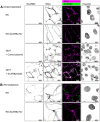Enterovirus A71 does not meet the uncoating receptor SCARB2 at the cell surface
- PMID: 38359079
- PMCID: PMC10901359
- DOI: 10.1371/journal.ppat.1012022
Enterovirus A71 does not meet the uncoating receptor SCARB2 at the cell surface
Abstract
Enterovirus A71 (EV-A71) infection involves a variety of receptors. Among them, two transmembrane protein receptors have been investigated in detail and shown to be critical for infection: P-selectin glycoprotein ligand-1 (PSGL-1) in lymphocytes (Jurkat cells), and scavenger receptor class B member 2 (SCARB2) in rhabdomyosarcoma (RD) cells. PSGL-1 and SCARB2 have been reported to be expressed on the surface of Jurkat and RD cells, respectively. In the work reported here, we investigated the roles of PSGL-1 and SCARB2 in the process of EV-A71 entry. We first examined the expression of SCARB2 in Jurkat cells, and detected it within the cytoplasm, but not on the cell surface. Further, using PSGL-1 and SCARB2 knockout cells, we found that although both PSGL-1 and SCARB2 are essential for virus infection of Jurkat cells, virus attachment to these cells requires only PSGL-1. These results led us to evaluate the cell surface expression and the roles of SCARB2 in other EV-A71-susceptible cell lines. Surprisingly, in contrast to the results of previous studies, we found that SCARB2 is absent from the surface of RD cells and other susceptible cell lines we examined, and that although SCARB2 is essential for infection of these cells, it is dispensable for virus attachment. These results indicate that a receptor other than SCARB2 is responsible for virus attachment to the cell and probably for internalization of virions, not only in Jurkat cells but also in RD cells and other EV-A71-susceptible cells. SCARB2 is highly concentrated in lysosomes and late endosomes, where it is likely to trigger acid-dependent uncoating of virions, the critical final step of the entry process. Our results suggest that the essential interactions between EV-A71 and SCARB2 occur, not at the cell surface, but within the cell.
Copyright: © 2024 Nishimura et al. This is an open access article distributed under the terms of the Creative Commons Attribution License, which permits unrestricted use, distribution, and reproduction in any medium, provided the original author and source are credited.
Conflict of interest statement
The authors have declared that no competing interests exist.
Figures









Similar articles
-
Cellular receptors for enterovirus A71.J Biomed Sci. 2020 Jan 10;27(1):23. doi: 10.1186/s12929-020-0615-9. J Biomed Sci. 2020. PMID: 31924205 Free PMC article. Review.
-
Novel virulence determinants in VP1 regulate the assembly of enterovirus-A71.J Virol. 2024 Dec 17;98(12):e0165524. doi: 10.1128/jvi.01655-24. Epub 2024 Nov 13. J Virol. 2024. PMID: 39535185 Free PMC article.
-
3,4-Dicaffeoylquinic Acid from the Medicinal Plant Ilex kaushue Disrupts the Interaction Between the Five-Fold Axis of Enterovirus A-71 and the Heparan Sulfate Receptor.J Virol. 2022 Apr 13;96(7):e0054221. doi: 10.1128/jvi.00542-21. Epub 2022 Mar 23. J Virol. 2022. PMID: 35319229 Free PMC article.
-
Type I Interferon-Induced TMEM106A Blocks Attachment of EV-A71 Virus by Interacting With the Membrane Protein SCARB2.Front Immunol. 2022 Mar 11;13:817835. doi: 10.3389/fimmu.2022.817835. eCollection 2022. Front Immunol. 2022. PMID: 35359978 Free PMC article.
-
EV-A71 Mechanism of Entry: Receptors/Co-Receptors, Related Pathways and Inhibitors.Viruses. 2023 Mar 18;15(3):785. doi: 10.3390/v15030785. Viruses. 2023. PMID: 36992493 Free PMC article. Review.
Cited by
-
Insight into the Life Cycle of Enterovirus-A71.Viruses. 2025 Jan 27;17(2):181. doi: 10.3390/v17020181. Viruses. 2025. PMID: 40006936 Free PMC article. Review.
-
Mechanism of enterovirus VP0 maturation cleavage based on the structure of a stabilised assembly intermediate.PLoS Pathog. 2024 Sep 19;20(9):e1012511. doi: 10.1371/journal.ppat.1012511. eCollection 2024 Sep. PLoS Pathog. 2024. PMID: 39298524 Free PMC article.
-
Mechanism of enterovirus VP0 maturation cleavage based on the structure of a stabilised assembly intermediate.bioRxiv [Preprint]. 2024 Apr 6:2024.04.06.588229. doi: 10.1101/2024.04.06.588229. bioRxiv. 2024. Update in: PLoS Pathog. 2024 Sep 19;20(9):e1012511. doi: 10.1371/journal.ppat.1012511. PMID: 38617325 Free PMC article. Updated. Preprint.
-
Virus adaptation to heparan sulfate comes with capsid stability tradeoff.Elife. 2024 Dec 23;13:e98441. doi: 10.7554/eLife.98441. Elife. 2024. PMID: 39714930 Free PMC article.
References
MeSH terms
Substances
Grants and funding
LinkOut - more resources
Full Text Sources
Molecular Biology Databases
Research Materials
Miscellaneous

